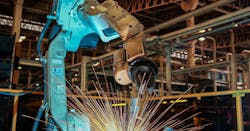According to reports by the International Federation of Robotics, in 2017 there was a global average of 74 robot units to every 10,000 employees in the manufacturing industry. As the industry’s reliance on robotics grows, manufacturers must ensure that they do all that they can to keep workers safe. In this article we’ll explain what manufacturers should consider when introducing collaborative robots to the production line.
Industrial robots are traditionally considered as dangerous machines that complete the dirty, dull and dangerous jobs on a production line and are often caged to avoid injuring human workers. However, there are some tasks that require the repeatability of a robot and the dexterity of humans combined that large industrial robots cannot complete alone.
In the 1990s, manufacturers began to introduce industrial robots that could safely work around humans. These collaborative robots are built to be smaller, lighter and safer than traditional industrial robots.
Now, facilities use cobots that can work alongside or even directly with humans to help improve productivity in various tasks, such as lifting, assembly, inspection or handling dangerous materials. However, as more machines come out of their cages, manufacturers cannot assume that collaborative robots are inherently safe.
UP TO STANDARD
ISO/TS 15066 was first introduced in 2006 to ensure that any machines classed as collaborative met certain safety requirements. According to the regulation, cobots require at least one safety feature such as a safety-rated monitored stop, hand guiding, speed and separation monitoring, or power and force limiting.
If manufacturers want to use a robot in a collaborative setting, it must have at least one of these safety features. Then, if a robot does incidentally come into contact with a human, it will not result in pain or injury.
RISK ASSESSMENT
When introducing any new equipment to the facility, manufacturers should carry out a thorough risk assessment. This assessment should consider the entire collaborative workspace and look at how the operator will interact with the robot. Manufacturers should take the time to ensure they risk assess every potential contact situation between the operator and cobot for each job that the robot is expected to complete.
Engineers should be careful to assess every action that the robot will complete in detail; an oversimplified assessment will not accurately represent how safe the robot will be. Manufacturers should consider the safety concept of ALARA (as low as reasonably achievable). This suggests that manufacturers should consider all the risks in a robot application, not just one or two.
The assessor should also share the information with operators once the assessment is complete. The people who are using the machine need to know about the potential risks. After detecting any hazards, assessors must also say how they will mitigate these risks with controls. Assessors also need to link each hazard to a control, a step that is regularly missed during assessments.
DO NO HARM
While a cobot is regarded as safer than a bulky, industrial robot, manufacturers should consider how more equipment can improve safety or increase risk of injury. For example, a cobot may be safe to operate around humans, but the end-of-arm tooling might be harmful if it includes an attached knife or welding tool.
While robots take humans away from hazardous tasks, manufacturers should not assume that there is no longer a risk of injury. Manufacturers should take the time to ensure that any robots that enter a collaborative space with humans are not going to cause more harm than good.
Jonathan Wilkins is director at EU Automation, a supplier of industrial automation parts.
